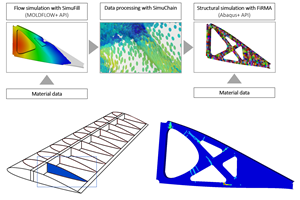It's time for the U.S. to invest in advanced composites manufacturing
Consultant and president of Quickstep Composites (Dayton, Ohio) Dale Brosius suggests that it’s time for an Institute for Manufacturing Innovation (IMI), created under the proposed U.S. National Network for Manufacturing Innovation (NNMI).
In January, U.S. President Barack Obama announced the creation of the Next Generation Power Electronics Manufacturing Innovation Institute in North Carolina, supported by the U.S. Department of Energy (DoE). This is the second such Institute for Manufacturing Innovation (IMI) created under the proposed National Network for Manufacturing Innovation (NNMI); the first is a pilot institute for additive manufacturing, formed in August 2012 in Youngstown, Ohio. As I am writing this, two additional institutes, one for lightweight metals and another for digital manufacturing and design, both led by the U.S. Department of Defense (DoD), are expected to be created shortly.
These four institutes are the first of what could be up to 45 such public/private partnerships within the NNMI. All would be focused on bridging the gap between research and commercialization of new technologies, and each would promote cooperation between industry, universities and the federal government. The concept is modeled after Germany’s Fraunhofer Institutes (famous for developing MP3 technology for digital music encoding). In the composites arena, Fraunhofer has pioneered advancements in direct long fiber thermoplastics (D-LFT), direct SMC manufacture and molding, and high-speed resin transfer molding (HP-RTM), among others. These technologies are in commercial use today, mainly in the European auto industry, and are being introduced worldwide.
So, is a U.S. institute for composites manufacturing on the horizon? Based on recent DoE activities, it looks promising. In August 2013, the Advanced Manufacturing Office (AMO) within DoE’s Office of Energy Efficiency and Renewable Energy issued a Request for Information (RFI), seeking input from industry, academia and others on the issues that are holding back advanced composites penetration into key markets, such as wind energy, automotive and energy storage. This was followed by a second RFI, in December, and a well-attended workshop in Washington, D.C., on Jan. 13, 2014. Speculation is that a funding announcement and proposal solicitation are forthcoming (and could be reality by the time this column reaches you).
Should this occur, it would certainly be a boost for U.S. composites development. Although such an institute would be aimed principally at reducing the costs and speeding production of carbon fiber composites, there will be opportunities for carbon/glass hybrids where they makes sense from a cost, weight and design perspective. The DoE, through Oak Ridge National Laboratories (Oak Ridge, Tenn.), is already investing in lower-cost carbon fiber manufacturing. The new institute would focus on the manufacturing processes used to convert fiber to finished parts, which today are slow and expensive. There are key industries and applications that can fulfill DoE’s objective of producing more clean energy and reducing energy consumption.
The wind energy industry will be one of the first to benefit. Currently, U.S. installed wind energy capacity is around 70 GW, more than three times that in 2008, according to DoE reports, and wind-generated electricity costs are around $0.07/kWh, edging closer to nonrenewable energy costs. Larger turbines with longer blades that capture more wind are the key to achieving cost parity, and incorporating carbon fiber into blade spars will enable long-blade manufacture. Efforts to develop new methods, such as high-speed pultrusion, for fabricating spar caps using low-cost carbon fiber and new fast-curing resins could yield success within a couple of years.
To no one’s surprise, the “elephant in the room” is the automotive and heavy-truck industry. Lighter vehicles, enabled via multimaterial solutions that include aluminum and carbon or carbon/glass composites, consume less fuel and help OEMs achieve fuel-efficiency targets. A focus on the design and high-speed manufacture of advanced composite structures (thermoset and thermoplastic) could make this possible. But repair and recycling must be addressed. Rapid production of high-pressure storage tanks could accelerate adoption of hydrogen fuel-cell and natural gas vehicles.
It’s important that the DoE is leading this, rather than the DoD, which has traditionally been more concerned with performance than with cost and high production rates. The U.S. Midwest seems the most logical location, but the winning proposal could come from anywhere. A successful consortium will include a broad spectrum of companies across the entire value chain, and must win support from universities with complementary expertise, trade and professional organizations, and other government entities, national and local. The time is now for the U.S. government to play a larger — and leading — role in the future mass production of affordable, high-performance composites.
Related Content
Fraunhofer IGCV develops helicopter door shell using SMV composite
SMC-replacement material subjected to vario-thermal pressing cycle achieved a 1.2-millimeter-thick, complex-shaped door shell, demonstrating feasibility for future aerospace components.
Read MoreNational Composites announces partners with compression toolmaker Laval
The new alliance will broaden National Composites’ capabilities in SMC and BMC and tooling, while providing customers with comprehensive solutions, from initial design to final delivery.
Read MoreImproving carbon fiber SMC simulation for aerospace parts
Simutence and Engenuity demonstrate a virtual process chain enabling evaluation of process-induced fiber orientations for improved structural simulation and failure load prediction of a composite wing rib.
Read MoreMar-Bal expands SMC expertise through AltraSet materials division
The BMC company aims to fill the SMC market gap for those seeking optimal, low-volume demand with custom formulation and high material value.
Read MoreRead Next
Cutting 100 pounds, certification time for the X-59 nose cone
Swift Engineering used HyperX software to remove 100 pounds from 38-foot graphite/epoxy cored nose cone for X-59 supersonic aircraft.
Read MoreUltrasonic welding for in-space manufacturing of CFRTP
Agile Ultrasonics and NASA trial robotic-compatible carbon fiber-reinforced thermoplastic ultrasonic welding technology for space structures.
Read MoreScaling up, optimizing the flax fiber composite camper
Greenlander’s Sherpa RV cab, which is largely constructed from flax fiber/bio-epoxy sandwich panels, nears commercial production readiness and next-generation scale-up.
Read More











